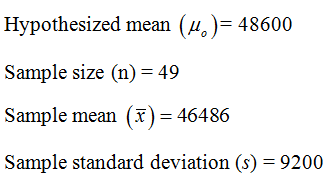The average salary for American college graduates is $48,600. You suspect that the average is less for graduates from your college. The 49 randomly selected graduates from your college had an average salary of $46,486 and a standard deviation of $9,200. What can be concluded at the αα = 0.01 level of significance? For this study, we should use Select an answer t-test for a population mean z-test for a population proportion The null and alternative hypotheses would be: H0:H0: ? p μ Select an answer = ≠ > < H1:H1: ? μ p Select an answer > ≠ = < The test statistic ? z t = (please show your answer to 3 decimal places.) The p-value = (Please show your answer to 4 decimal places.) The p-value is ? > ≤ αα Based on this, we should Select an answer reject accept fail to reject the null hypothesis. Thus, the final conclusion is that .
The average salary for American college graduates is $48,600. You suspect that the average is less for graduates from your college. The 49 randomly selected graduates from your college had an average salary of $46,486 and a standard deviation of $9,200. What can be concluded at the αα = 0.01 level of significance?
- For this study, we should use Select an answer t-test for a population mean z-test for a population proportion
- The null and alternative hypotheses would be:
H0:H0: ? p μ Select an answer = ≠ > <
H1:H1: ? μ p Select an answer > ≠ = <
- The test statistic ? z t = (please show your answer to 3 decimal places.)
- The p-value = (Please show your answer to 4 decimal places.)
- The p-value is ? > ≤ αα
- Based on this, we should Select an answer reject accept fail to reject the null hypothesis.
- Thus, the final conclusion is that .
The provided information are:

The appropriate null and alternative hypotheses are:

The alternative hypothesis suggests that the test is left-tailed
(1)
Here, the population standard deviation is unknown, so the appropriate test is t-test.
The test statistic can be calculated as:

The sample size (n) is 49.
Degrees of freedom (df) = n-1 = 49-1=48
(2)
The P-value can be calculated as:

Step by step
Solved in 5 steps with 4 images









